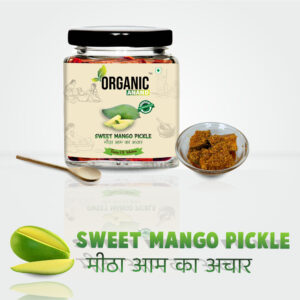Indian cuisine is a kaleidoscope of flavors, and at the heart of it lies an array of delectable pickles that add zest and charm to every meal. One such pickle that captures the essence of tradition and tantalizes taste buds is “Sweet Keri Ka Achar,” also known as jaggery mango pickle. In this article, we’ll delve deep into the world of Sweet Keri Ka Achar, exploring its rich history, ingredients, preparation, and its special place in Indian culinary culture.

Pickles, or achars, have been an integral part of Indian cuisine for centuries. They were initially developed as a means to preserve fruits and vegetables, ensuring that they could be enjoyed year-round, regardless of the season. Over time, these preservation methods evolved into a culinary art form, with regional variations and family recipes being passed down through generations.
Sweet Keri Ka Achar, in particular, holds a special place in the culinary heritage of India. The use of raw mangoes and jaggery dates back to ancient times when these ingredients were revered for their health benefits and culinary versatility. Today, this pickle continues to be a beloved addition to Indian meals, evoking nostalgia and connecting generations through its time-tested flavors.
Sweet Keri Ka Achar is a unique and tantalizing pickle that stands out for its harmonious blend of sweet and tangy flavors. At its core, this pickle is a celebration of two primary ingredients: raw mangoes and jaggery. Let’s take a closer look at what makes these ingredients so special:
1. Raw Mangoes: The star of the show, raw mangoes, provide the pickle with its characteristic tanginess. Packed with vitamins (particularly vitamin C), antioxidants, and minerals, raw mangoes are not only delicious but also offer a range of health benefits. Their crisp and slightly sour taste infuses the pickle with an invigorating zing.
2. Jaggery: Jaggery, a traditional Indian sweetener, plays the role of balancing the pickle’s tanginess with its natural sweetness. Made from sugarcane or date palm sap, jaggery is rich in iron, calcium, and other essential nutrients. It imparts a deep, caramel-like sweetness to Sweet Keri Ka Achar, making it a unique sensory experience.
Creating this delectable pickle is an art that has been passed down through generations. The process requires precision, patience, and a deep understanding of flavor profiles. Here’s a glimpse into how Sweet Keri Ka Achar is made:
One of the delightful aspects of Sweet Keri Ka Achar is its versatility. It can be paired with a wide range of dishes, making it an ideal accompaniment for various Indian meals. Here are some popular ways to enjoy this pickle:
While Sweet Keri Ka Achar is undeniably a culinary delight, its significance goes beyond its delectable taste. It serves as a symbol of preserving India’s rich culinary traditions. Each bite of this pickle carries with it the legacy of generations, connecting us to the roots of our culture.
In a world where fast food and processed meals often take center stage, dishes like Sweet Keri Ka Achar remind us of the importance of slow cooking, traditional recipes, and the flavors that have been cherished for centuries. It’s a reminder that food isn’t just sustenance; it’s a piece of history and a source of cultural pride.